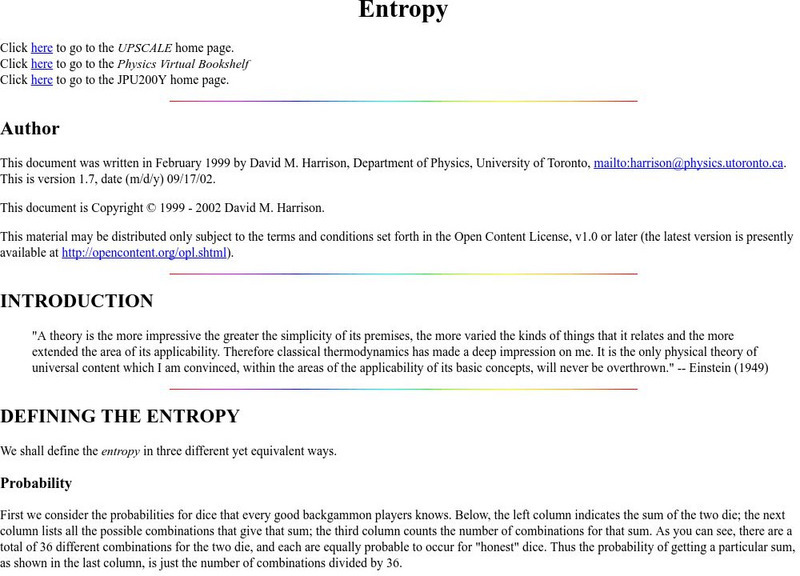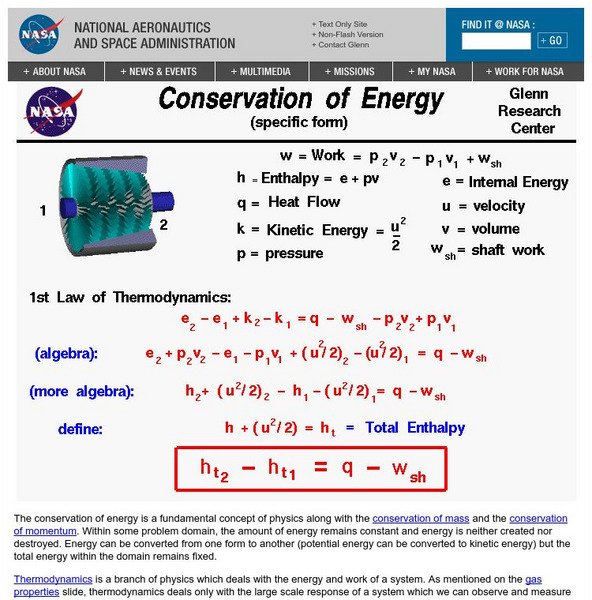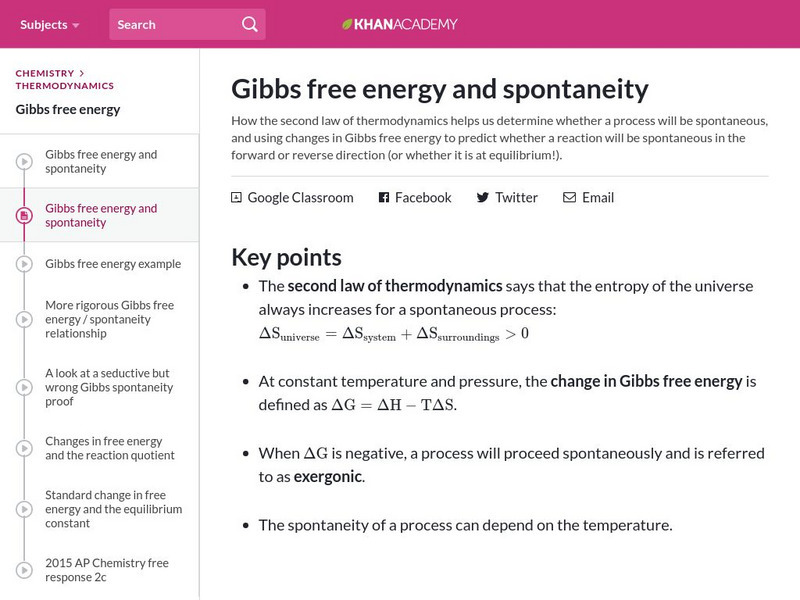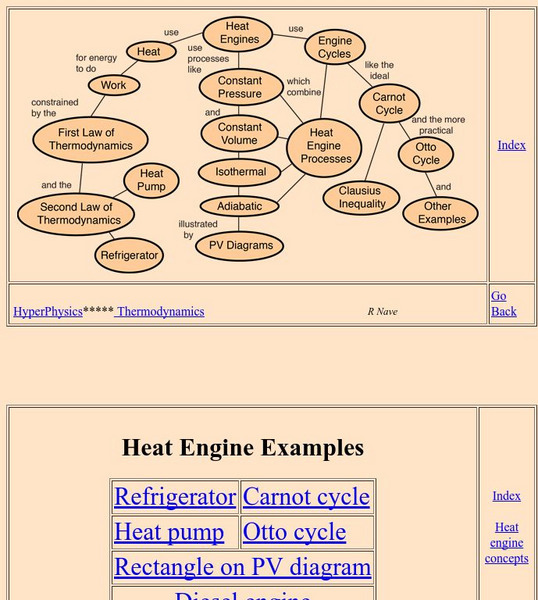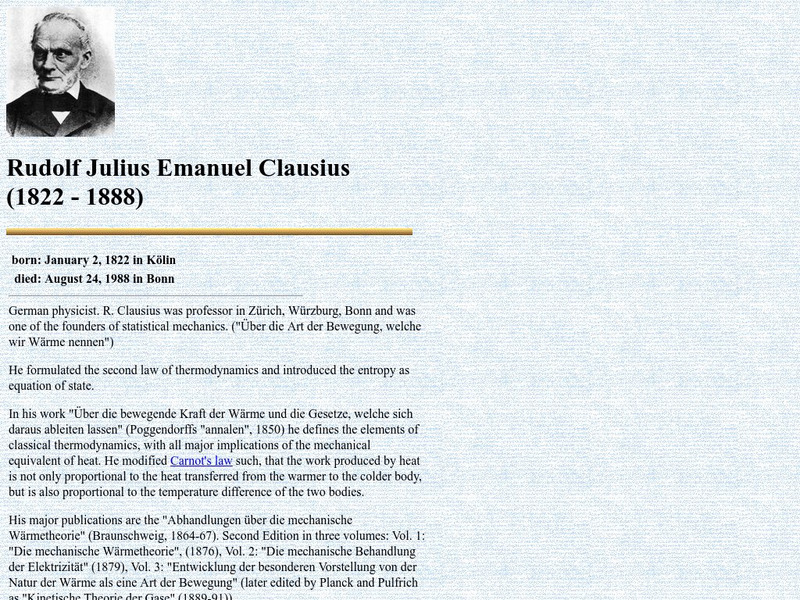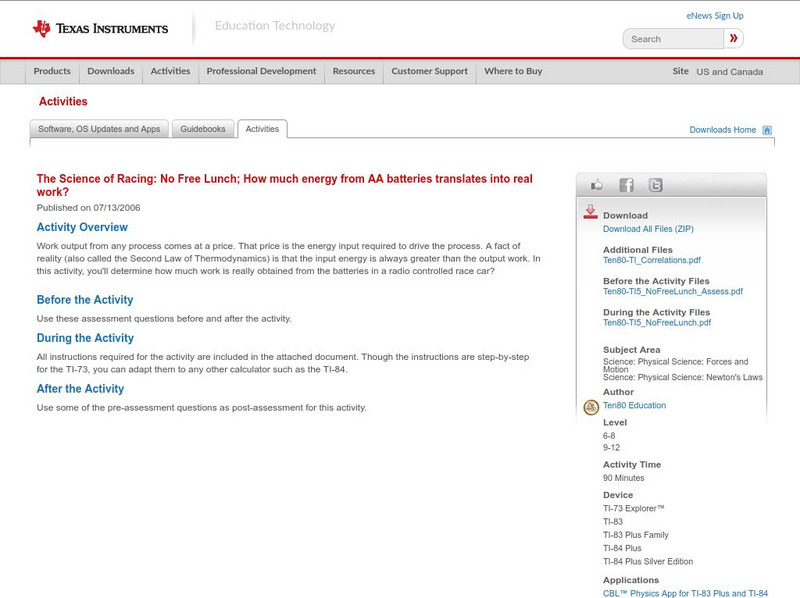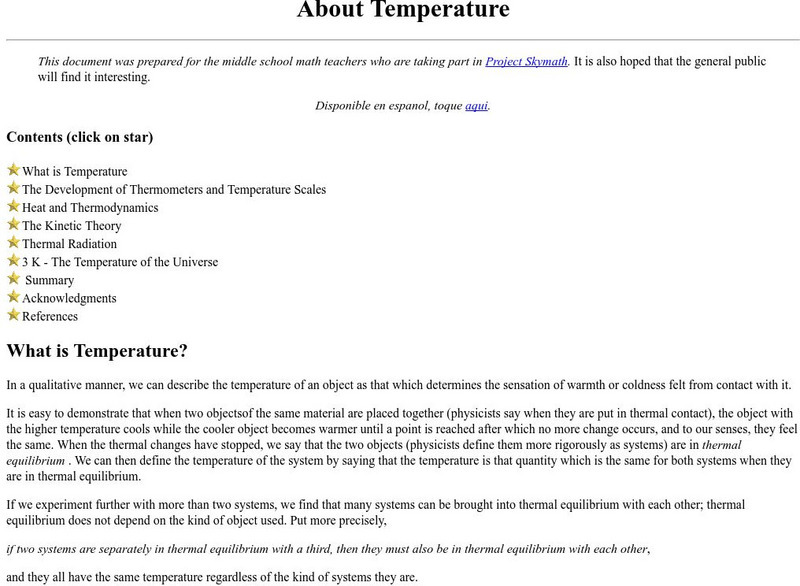Curated OER
Heat and the Second Law of Thermodynamics
More than a week's worth of investigation is provided in this source. Physical science stars experiment to describe specific heat, conduction, convection, and radiation. They also discover the relationship between mechanical and thermal...
Curated OER
Energy: The Universal Currency
Science stars examine the concept of energy by thinking about everyday situations. The lesson plan is incohesive. It lists goals for the student, but doesn't address all of them in the content. The best use of this resource would simply...
Curated OER
Entropy
In this entropy learning exercise, students review the Second Law of Thermodynamics and explore how entropy changes. This learning exercise has 5 word problems.
Curated OER
Pendulum Power
Eighth graders study the Law of Conservation of Energy and the Second Law of Thermodynamics. they create a pendulum out of either a rope with a bowling ball or barbell tied to one end.
University of Toronto (Canada)
University of Toronto: Entropy
A discussion of entropy that focuses on explaining entropy, how it applies to the second law of thermodynamics, and real-life observations of the existence of entropy.
NASA
Glenn Research Center: Conservation of Energy
From the Glenn Research Center at NASA, read about the law of conservation of energy. Included are formulas and many links to key terms.
Khan Academy
Khan Academy: Bond Enthalpy and Enthalpy of Reaction
Explanation of bond enthalpy that includes examples of calculating enthalpies of reaction using bond enthalpy.
Khan Academy
Khan Academy: Gibbs Free Energy and Spontaneity
Explanation of Gibbs Free Energy and Spontaneity. Includes formulas and examples.
Texas Education Agency
Texas Gateway: Thermodynamics: Conceptual Questions
This is a list of 37 question that cover the major concepts presented in Chapter 15: Thermodynamics from the AP Physics online text.
Texas Education Agency
Texas Gateway: Thermodynamics: Problems and Exercises
This is a list of 67 problems and exercises to solve based on the content presented in Chapter 15: Thermodynamics from the AP Physics online text.
Georgia State University
Georgia State University: Hyper Physics: Heat Engine Concepts: The Otto Cycle
Schematic diagrams illustrating the operation of a four-stroke engine cycle. Interactive buttons allow you to step through the various steps of each engine cycle. Each graphic is accompanied by an excellent explanation.
Georgia State University
Georgia State University: Hyper Physics: Heat Engine Concepts: Carnot Cycle
The Carnot cycle is described, illustrated and explained. The Carnot efficiency equation is given and interactive JavaScript form allows the visitor to investigate the effect of the reservoir temperature and the sink temperature upon the...
Georgia State University
Georgia State University: Hyper Physics: Law Concepts
This site from Georgia State University Department of Physics and Astronomy is an indexing page for the HyperPhysics site. The page links to a variety of other pages which discuss concepts related to entropy and the second law of...
Georgia State University
Georgia State University: Hyper Physics: Heat Engine Cycle
The heat engine cycle is defined and discussed. So pressure-volume diagrams are introduced and their use in depicting the cycles of a heat engine is demonstrated. Informative graphics are accompanied by reason-filled explanations.
Georgia State University
Georgia State University: Hyper Physics: Heat Engine Concepts
An indexing page for the HyperPhysics site. The page contains a concept map of links to a variety of other pages which discuss concepts related to heat engines. All pages contain informative graphics and excellent explanations.
University of Waterloo (Canada)
University of Waterloo: Rudolf Julius Emanuel Clausius
Lists the most important publications of Rudolf Clausius. Provides some biographical details. Part of a set of History of Thermodynamics course notes.
Texas Instruments
Texas Instruments: The Science of Racing: How Much Energy From Aa Batteries
Work output from any process comes at a price. That price is the energy input required to drive the process. A fact of reality (also called the Second Law of Thermodynamics) is that the input energy is always greater than the output...
Wikimedia
Wikipedia: The Laws of Thermodynamics
A Wikipedia article summarizing each of the laws of thermodynamics. Links are provided throughout the article for additional information.
Estrella Mountain Community College
Estrella Mountain: Laws of Thermodynamics
Estrella Mountain Community College provides excellent introductory information on the laws of thermodynamics. Has some learning objectives outlined at the end of the page.
Simon Fraser University
Chem1 Virtual Textbook: Heat and Work
With an overview of topics related to chemical energetics, this resource provides a foundation to a study of the second Law of Thermodynamics emphasizing the transformation in energy involved in work.
Concord Consortium
Concord Consortium: Molecular Workbench: Loschmidt's Paradox
Use this simulation to observe how Loschmidt's Paradox affects the entropy of an isolated system.
Georgia State University
Georgia State University: Hyper Physics: Heat Pump
Heat flow from a hot region to a cold region is described and explained. Applications of this phenomenon (specifically heat pumps and refrigerators) are discussed. Excellent graphics.
Georgia State University
Georgia State University: Hyper Physics: Entropy
This informative site is from Georgia State University. The tendency of nature to move towards a more disordered state in an isolated system, a concept known as entropy, is discussed. This concept is well-depicted in meaningful diagrams.
University Corporation for Atmospheric Research
Ucar: About Temperature
This site from the University Corporation of Atmospheric Research provides a lengthy page covering numerous topics including the difference between heat and temperature, the use of different temperature scales, thermal expansion, how a...






